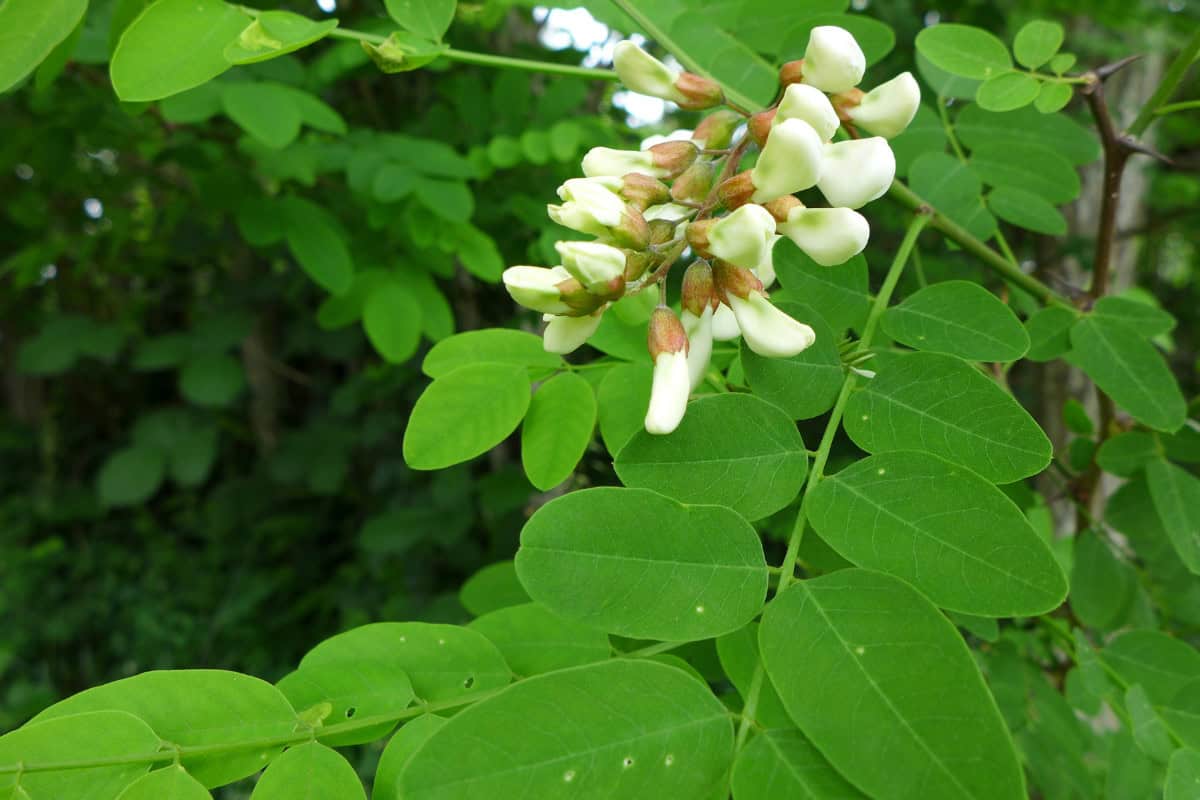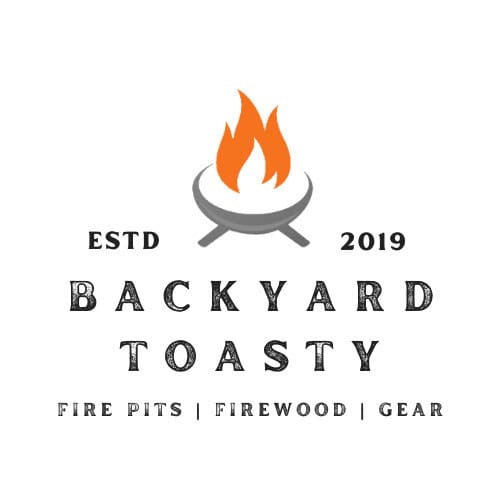
This comprehensive Black Locust firewood profile explores one of nature’s most impressive heating woods, delivering nearly 28,000 BTUs per cord with remarkably clean burning characteristics.
Whether you’re planning relaxing evening fires or need serious heat for cold-weather gatherings, Black Locust consistently ranks among the top choices for discerning fire pit owners.
Quick Reference Stats
- Wood Type: Hardwood
- BTU Rating: 27,900 BTUs per cord
- Ease of Splitting: Difficult (2/5 scale)
- Seasoning Time: 12-18 months
- Smoke Production: Very Low
- Spark/Pop Factor: Very Low
- Scent Profile: Pleasant – Sweet, honey-like aroma
Overview & Identification
Black Locust stands as one of the premium hardwoods for fire pit enthusiasts. This dense powerhouse delivers exceptional heat output while burning cleanly. Many consider it the gold standard for overnight burns and cold-weather fires.
Common Names: Black Locust, False Acacia, Yellow Locust, Post Locust Scientific Name: Robinia pseudoacacia Tree Characteristics: Medium-sized tree reaching 40-100 feet tall. Features deeply furrowed dark bark and compound leaves with 7-19 leaflets. Notable for sharp thorns on younger branches.
Geographic Distribution
Where You’ll Find It: Originally native to Appalachian Mountains, now widespread across most of the United States. Particularly common in the Southeast, Mid-Atlantic, and parts of the Midwest.
Availability: Moderately common in most regions, though pricing varies significantly by location
Growing Conditions: Thrives in poor soils and harsh conditions. Actually improves soil quality through nitrogen fixation, making it popular for land reclamation projects.
Burning Characteristics
Heat Output & Performance
- BTU Content: Among the highest of all firewood species, delivering nearly 30% more heat than oak
- Burn Duration: Burns extremely slowly with exceptional heat retention
- Coaling Properties: Forms dense, long-lasting coals perfect for extended warmth
- Flame Characteristics: Steady, moderate flames with beautiful blue-orange color
Ignition & Fire Management
- Ease of Lighting: Challenging to ignite due to density – requires good kindling and established fire
- Best Fire Stage: Excellent primary fuel and outstanding for overnight burns
- Burn Rate: Very slow consumption provides maximum burn time per log
- Heat Consistency: Remarkably steady heat output with minimal temperature fluctuation
Sensory Experience
Smoke Profile
- Smoke Volume: Minimal smoke production when properly seasoned
- Smoke Color: Nearly invisible when burning well
- Smoke Flavor: Clean, slightly sweet – excellent for cooking applications
- Creosote Production: Very low due to clean burning characteristics
Sound & Visual
- Crackling/Popping: Very quiet burning with minimal crackling
- Sparking Tendency: Virtually no sparking – excellent safety profile for open fires
- Flame Appearance: Steady, mesmerizing flames with attractive blue and orange hues
Aroma
- Burning Scent: Distinctive sweet, honey-like fragrance that most people find appealing
- Pleasant Factor: Highly rated – creates a cozy, welcoming atmosphere
- Intensity: Moderate intensity that isn’t overwhelming
Processing & Preparation
Splitting Characteristics
- Ease of Splitting: Quite difficult due to extreme density and occasional twisted grain
- Grain Pattern: Usually straight but can develop interlocked patterns in older trees
- Tools Needed: Hydraulic splitter recommended for larger pieces – hand splitting is exhausting
- Best Splitting Conditions: Split when green if possible, becomes much harder when dry
Seasoning Requirements
- Drying Time: 12-18 months minimum for proper seasoning
- Moisture Content: Target 15-20% moisture content for optimal burning
- Seasoning Tips: Stack with excellent air circulation – the density makes drying slow
- Storage Considerations: Requires longer seasoning time but stores exceptionally well once dry
Processing Notes
- Chainsaw Considerations: Dense wood that can dull chains quickly – keep sharp chains ready
- Bark Characteristics: Thick, deeply furrowed bark that stays attached during processing
- Handling: Extremely heavy – a cord weighs significantly more than most other species
Specialized Uses
Cooking Applications
- Cooking Suitability: Excellent for cooking due to clean burn and steady heat
- Flavor Profile: Imparts subtle sweetness – pairs beautifully with pork and poultry
- Cooking Stage: Outstanding for low-and-slow cooking and maintaining steady temperatures
- Food Safety: Clean burning makes it safe for all cooking applications
Pest Control
- Insect Repelling: Some anecdotal evidence suggests mild mosquito deterrent properties
- Active Compounds: Contains natural compounds that may discourage some insects
- Application Method: Normal burning provides any pest control benefits
Pros & Cons
Advantages
- Exceptional heat output – among the highest BTU ratings available
- Burns very cleanly with minimal smoke production
- Creates long-lasting coals perfect for extended warming
- Pleasant, sweet aroma enhances the fire pit experience
- Extremely safe – virtually no sparking or dangerous burning characteristics
- Excellent for cooking applications
Disadvantages
- Difficult and labor-intensive to split
- Takes longer to season than most hardwoods
- Can be challenging to ignite initially
- Often more expensive than common alternatives
- Very heavy – handling large quantities requires physical strength
Best Practices & Tips
Fire Pit Optimization
- Ideal Fire Size: Perfect for medium to large fires where maximum heat is desired
- Mixing Recommendations: Combine with easier-lighting woods like oak or ash for best results
- Safety Considerations: Low spark production makes it ideal for open fire pits
- Weather Suitability: Outstanding performance in cold weather – maintains heat in wind
Purchasing & Storage
- What to Look For: Dense, heavy pieces with minimal checking or splitting
- Pricing Expectations: Premium pricing – typically 20-50% more than standard hardwoods
- Storage Lifespan: Stores exceptionally well for years when properly seasoned
Bottom Line
Black Locust represents the premium choice for serious fire pit users who prioritize maximum heat output and clean burning.
While it requires more effort to process and season, the payoff comes in exceptional performance and efficiency.
Best For: Cold climate heating, overnight burns, cooking applications, and anyone wanting maximum heat per log
Skip If: You need easily split wood, quick seasoning times, or budget-friendly options
For a complete breakdown of Black Locust’s exceptional performance characteristics and technical specifications, our detailed quick reference table below provides all the precise data behind this cold-weather champion.
🌳 Black Locust Quick Reference Table 🔥
Black Locust is the cold-weather champion that serious heaters swear by for maximum performance! This powerhouse delivers an incredible 27,900 BTUs per cord – among the highest available from any North American wood – while creating those legendary long-lasting coals that keep the heat going all night long. Yes, it demands respect with challenging splitting that requires hydraulic equipment and premium pricing, but when winter temperatures plummet and you need marathon heating performance with that sweet honey-like aroma, nothing matches Black Locust’s top-tier capabilities. It’s the ultimate investment for those who refuse to compromise on heating power! 🏆✨
| Characteristic | Rating/Value | Notes |
|---|---|---|
| 🔥 BTU per Cord | 27,900 🚀 | Among highest available |
| ⚖️ Density | Very High 💎 | Extremely heavy wood |
| ⏰ Seasoning Time | 12-18 months ⏳ | Longer than average |
| 🪓 Splitting Difficulty | Difficult (2/5) 💪 | Hydraulic splitter recommended |
| 💨 Smoke Production | Very Low ✨ | Clean burning |
| ✨ Spark/Pop Factor | Very Low 🛡️ | Excellent safety profile |
| 🚀 Ignition Ease | Challenging 🎯 | Needs established fire |
| ⚡ Burn Rate | Very Slow 🐌 | Maximum burn time |
| 🔥 Coaling Ability | Excellent 👑 | Long-lasting hot coals |
| 🌸 Scent Quality | Pleasant 🍯 | Sweet, honey-like aroma |
| 🍳 Cooking Suitability | Excellent 🥩 | Clean burn, steady heat |
| 🌱 Sustainability | Good 🌿 | Fast-growing pioneer species |
| 📍 Regional Availability | Eastern North America | Expanding range westward |
| 💰 Cost Level | Premium 💰 | 20-50% above standard hardwoods |
| 🎯 Best Use | Overnight burns, cold weather | Maximum heat applications |
| 🏆 Overall Rating | Top-tier performance |
Related Resources: Black Locust Firewood Profile
Last updated: 8/4/2025


